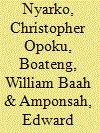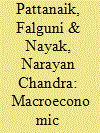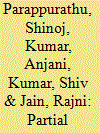|
|
|
Sort Order |
|
|
|
Items / Page
|
|
|
|
|
|
|
| Srl | Item |
| 1 |
ID:
130919


|
|
|
|
|
| Publication |
2014.
|
| Summary/Abstract |
The success of individuals in securing employment requires a significant search effort. This article presents an empirical analysis of the determinants of job search intensity among a cross-section of workers in Accra, Ghana. Based on a sample of 404 workers drawn from 100 formal sector firms in Accra, we adopt the Poisson regression estimation technique to indicate that age, years of schooling, labour market experience, sex of household head, firm size and ethnic group significantly influence job search intensity. Measures to expose young job seekers to the world of work via internship and apprenticeship could accelerate their transition to employment.
|
|
|
|
|
|
|
|
|
|
|
|
|
|
|
|
| 2 |
ID:
130917


|
|
|
|
|
| Publication |
2014.
|
| Summary/Abstract |
Despite India's resurgent growth over the past years, the country seems to have failed miserably on the employment front. The employment content of economic growth-the employment intensity of growth-is on the decline. The objective of the present study is to identify the macroeconomic determinants which influence the employment intensity of growth in India. The study covers data for the period 1993-94 to 2009-10 across 15 major Indian states and applies a panel data model to find out these determinants. The results tend to suggest that labour supply, economic structure, price instability and human capital are major determining factors. Pro-employment growth in India may require measures like diversification of economic activities towards labour-intensive sectors, price stability, skill-based education and adoption of labour-intensive technology.
|
|
|
|
|
|
|
|
|
|
|
|
|
|
|
|
| 3 |
ID:
130918


|
|
|
|
|
| Publication |
2014.
|
| Summary/Abstract |
A far-sighted food policy is essential to facilitate efficient functioning of food production and management systems, especially for a country like India where household level food security still remains elusive. In this context, reliable mechanisms for generating outlooks on key variables such as demand, supply, trade, prices, etc., of important food commodities forms an essential basis for planning. This paper explores the theoretical underpinnings as well as practical applications of the Cereal Outlook Model, a dynamic, partial-equilibrium model, developed by the authors with the specific purpose of generating future outlooks on major cereals in India. Based on this, projections as well as policy simulations on main demand and supply side variables of rice, wheat and maize were carried out for the period spanning 2011-2025. The model results indicate fast-growing trends in demand and supply of the three cereals considered. Though growth in demand would be sufficiently high due to growing per capita income, population and urbanisation; supply would keep pace owing to the emergence of new areas contributing towards incremental production. Consequently, the net trade of all three commodities would remain positive, though some signs of tapering off in net trade are expected in case of wheat and maize.
|
|
|
|
|
|
|
|
|
|
|
|
|
|
|
|
|
|
|
|
|